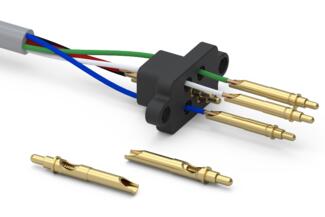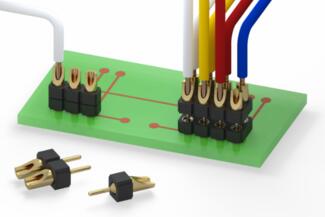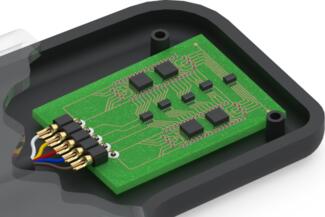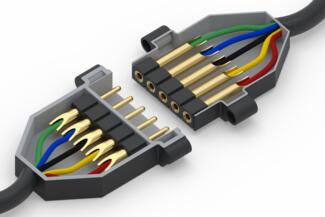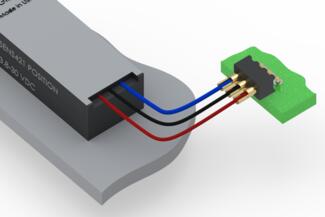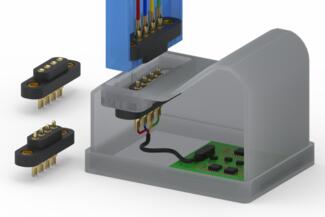How to Use Solder-Cup Pins, Receptacles and Interconnects
In electronic systems, using wires and cables to make connections between devices, PCB’s and discrete instruments is widespread, however, this process can often be challenging as the mating components may not share a common termination style. Attaching those wires and cables to pins, receptacles and connectors designed for this purpose will make these connections more functional and reliable. The two main methods used to make these connections are crimping or soldering the wires to terminals.
Here we are focusing on soldered connections and how a solder-cup feature simplifies and enhances this process. A solder-cup feature has two key attributes; a drilled hole and a portion of the hole exposed, by cutting away material (think of a tube that has the top half removed for a portion of its length). This terminal style is the most efficient and reliable type for soldering wires, it is widely used in connectors such as XLR, D-sub, Mil-Spec and many others.
The solder-cup is designed so the user can easily place the wire in the hole where it will remain stable during the soldering operation. The cut-away portion, or cup shape, allows for a quality solder fillet to form and, depending on the soldering style used, enables a soldering iron easy access to the wire and soldering area. In some soldering processes the iron is placed on the back of the cup while in others the iron is placed right on the exposed wire in the cup. The solder-cup design also allows for easy inspection of the solder joint due to the excellent visibility provided.
Solder-Cup Connector Options
Mill-Max manufactures a wide range of products with solder-cup features including male terminals, receptacles, spring-loaded pins and connectors assembled with these discrete components. There are solder-cup products to choose from which can accept wire sizes from 32 AWG to 14 AWG including: receptacles designed to accept mating pins from .015” to .082” (.38 – 2.08 mm); male terminals with pin diameters of .016: to .078” (.41 – 1.98 mm); spring-loaded pins with .055” to .090” (1.4 – 2.3 mm) stroke. Connectors are offered in vertical mount styles in single and double row while right angle versions are available in single row only. All solder-cup connector products have the cups uniformly aligned to facilitate efficient soldering. Right angle connectors are optimal for applications requiring parallel connections to the board or for minimizing the above-board height of components. Some recently released solder-cup connectors, particularly right-angle versions, incorporate new features and assembly techniques developed by Mill-Max to limit pin rotation in the insulator. This keeps the solder-cups oriented properly during handling and processing.
The following examples showcase some of the products Mill-Max offers to address a variety of wire termination applications.
Solder-Cup Receptacles
Receptacles combining Mill-Max’s high reliability contact clip technology with a solder-cup feature offer the convenience of interconnecting wires with leaded components. The solder-cup supports efficient soldering of wires, creating a secure connection, while the contact end allows a pin or lead to engage and disengage repeatedly and consistently.
A common application for these receptacles is to connect a wired component or device to a PCB, as shown here, so that the component is easily pluggable. Solder-cup receptacles also present an appealing solution for use as the female contact in cable connectors. A wide selection of individual receptacles, designed to accept different wire sizes and mating pins, is available for mounting in cable housings per the required configurations.
Solder-Cup Terminal Pins
Precision machined brass pins, designed with a solder-cup feature, provide an efficient means for transforming wires into functional interconnect components. These solder-cup terminal pins are commonly paired with receptacles and/or connectors to create reliable, pluggable connections to other wires and cables or to PCB’s. In wire to board applications, customers find these products useful for simplifying the connection process and providing a more robust connection than soldering wires directly to a PCB, especially when working with fine gauge wires. Combining solder-cup receptacles and terminals provides a reliable, high quality solution when selecting the critical components for cable connectors.
Spring-Loaded Contacts with Solder-Cups
Mill-Max spring-loaded pins and connectors, provide a highly-reliable, precision made interconnect solution ideal for a number of demanding application requirements. Spring-loaded pins with an integrated solder-cup offer a unique combination of interconnect options, such as battery leads soldered to spring pins mounted in a docking/charging station. The spring-loaded pin with solder-cup feature enables efficient attachment of wires while the spring-loaded plunger is the proper interface for mating to devices with pads or lands. Several of the spring-loaded pins include a press-fit feature for convenient mounting in assembly housings or boards.
In the example shown here, the 0973 spring-loaded pins are used in a cable assembly as part of a quick-connect system. In this application the wires are passed through the housing where they are soldered to the cups. The wires and pins are pulled back through the housing until the press-fit feature is engaged, then, pushing on the shoulders of the pins, they are secured into the housing. The spring pins are designed with the location of the shoulder and barb press-fit feature to ensure the pins will not be pulled from the insulator due to strain on the wires.
.100" (2,54 MM) Pitch Solder-Cup Pin & Socket Interconnects
Solder-cup terminal pins and receptacles assembled into insulators on .100” (2,54mm) pitch are available in a variety of options including low profile, right-angle and higher current versions. All styles have uniformly aligned solder-cups to facilitate efficient soldering and most series are offered in single and double row configurations. .100” (2,54mm) spaced connectors, the most common type, exhibit greater durability than the fine pitch offerings, allowing for termination of heavier gauge wires and operation in more demanding environments. Most connectors in this family will accept up to 22 AWG, they have an interconnect structure characterized by .020” (.51 mm) diameter leads on the male end and mating receptacles accepting .015” - .025” (.38 - .635 mm) The heavier gauge connectors are capable of handling up to 20 AWG wire and use .030” (.762 mm) diameter male pins and receptacles with an acceptance range of .025” - .037” (.635 - .94 mm).
Fine Pitch Solder-Cup Pin & Socket Interconnects
Fine Pitch solder-cup pin and socket Interconnects are a family of connectors offering wire termination solutions on a space saving .050” (1,27mm) pitch or 2mm pitch. These connectors incorporate high temperature insulators and precision machined pins and receptacles to provide high quality interconnects in a small-scale package. The smaller pitch of these interconnects required the development of new assembly processes to ensure uniform alignment of the cups, an important feature when handling small gauge wires and miniature components. Both headers and sockets may be mated with a variety of Mill-Max fine pitch connectors, allowing a user to mix and match termination styles to overcome diverse interconnect challenges.
In this example, a sensor is being connected to a PCB in a parallel orientation. The connector may be soldered to the board during board assembly via intrusive reflow, the most widely used process today. The wires are then soldered to the connector terminals; this may require a lower temperature solder so as not to disturb the solder joint to the PCB.
Spring-Loaded Headers and Target Connectors with Solder-Cups
Solder-cup termination spring pins and mating target pins assembled into high temperature insulated housings are available in .050” (1,27mm), .100” (2,54 mm) and .1575” (4mm) pitch. Offered in many unique vertical mounting styles including extended travel and rugged high-power offerings, these types of connectors are most commonly used in battery charging/docking station applications. Another popular use is in “quick connect” systems where blind mating is typically employed.
Care must be taken when soldering wires to spring pins as prolonged exposure to high temperature soldering irons can adversely affect the performance of the spring. Since there is variation in all applications, the process may have to be experimented with and adjusted as required.
Short term (1-hour max.) temperature ratings for Beryllium copper and stain-less steel springs are 205˚C (401˚F) and 260˚C (500˚F) respectively. Since lead free solder iron temperature recommendations are much higher, 371 – 427˚C (700 - 800˚F), the dwell time becomes critical. All spring-loaded headers and target connectors have uniformly aligned solder-cups to facilitate efficient soldering, and most are offered in single or double row configurations.
For additional help on how to correctly solder these type of terminals watch this video, Basic Soldering For Electronics Lesson 3 - "Cup Terminals", produced by PACE, Inc, or Contact an Applications Engineer




